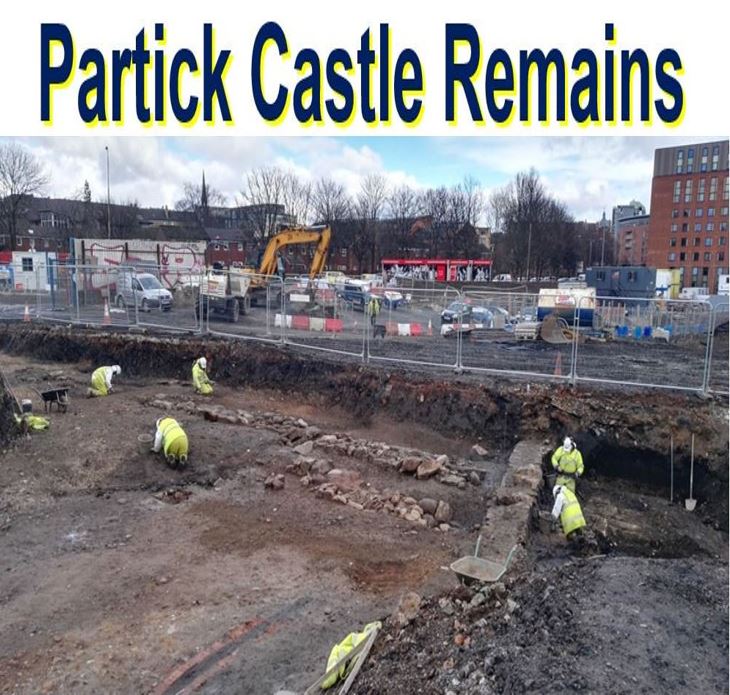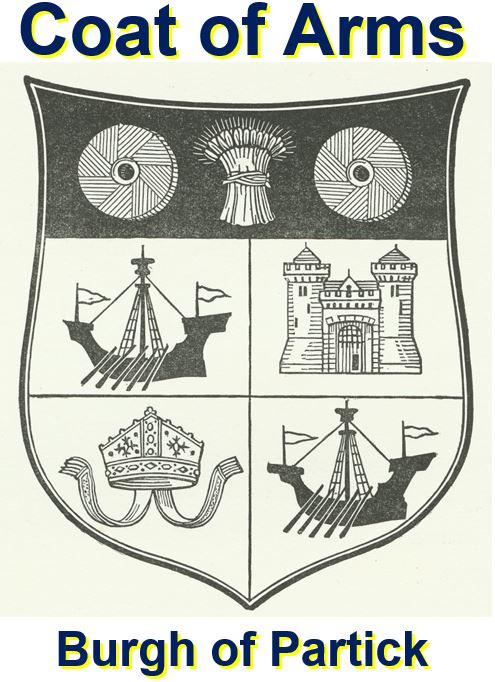The medieval remains of Partick Castle have been discovered by archaeologists working in Glasgow, Scotland, who had no idea they would come across such a significant find. Partick Castle, situated on the west bank of the River Kelvin, was built for Glasgow benefactor George Hutcheson in 1611.
Experts from GUARD Archeology Ltd., working on behalf of Scottish Water, said that although there was historical evidence suggesting there might be a royal estate at Partick when nearby Govan on the opposite south of the Clyde was an ecclesiastical centre, nobody had any idea they might encounter such important remains.
The ecclesiastical centre, which later became a seat of the Bishop of Glasgow, and its surroundings never showed any clear indications of other archaeological remains.
 The remains of two castles – one of them possibly dating as far back as the 12th century – have been discovered in Glasgow. Experts say this is the most significant archaeological find in Glasgow in a generation. (Image: guard-archaeology.co.uk)
The remains of two castles – one of them possibly dating as far back as the 12th century – have been discovered in Glasgow. Experts say this is the most significant archaeological find in Glasgow in a generation. (Image: guard-archaeology.co.uk)
Archaeologists amazed at the find
The overall site, archaeologists say, had been considerably disturbed by industrial workings during the 19th century. Everybody had assumed that the chances of finding any remains of the medieval castle of Partick were extremely remote.
Nobody knew, however, whether one slightly elevated area in the west of the site was the result of archeological remains lying underneath or whether it had been artificially raised during the clearing of later factories and industrial buildings. “This spot became the focus of our attention,” GUARD Archaeology wrote.
In the middle of a watching brief within this part of the development area, archaeologists discovered a series of archaeological features including several stone walls, a well, and a ditch.
As they excavated further they have unearthed considerable amounts of pottery, as well as leather, glass, metalwork and animal bones, suggesting a date range of 12th-13th century to the 17th century.
 In this coat of arms of the Burgh of Partic, you can see a sketch of the castle and the mitre of the Bishop of Glasgow. (Image: Wikipedia)
In this coat of arms of the Burgh of Partic, you can see a sketch of the castle and the mitre of the Bishop of Glasgow. (Image: Wikipedia)
Remains of two residences unearthed
Excavation leader, Beth Spence, said regarding the specimens being unearthed:
“This fits well with the historical references to the original Bishop’s residence being erected no earlier than the twelfth century and demolished in the early seventeenth century prior to a new tower house being constructed on the site.”
“So the archaeology we are encountering is probably the remains of both of these residences and what we will need to do once we have completed our excavation is disentangle the remains of the later tower house from the earlier castle.”
GUARD Project Manager, Warren Bailie, said:
“These findings are of national significance and provide a rare glimpse into the medieval beginnings of Partick and Glasgow. The survival of these medieval remains is especially remarkable given that the site, not unlike many industrial river banks across Britain, has witnessed such large-scale destructive development over the centuries.”
“However, this recent wave of development, part of Scottish Water’s programme of work to upgrade Glasgow’s waste water infrastructure, has seen Scottish Water work closely with GUARD Archaeology and West of Scotland Archaeology Service to ensure that this important site is afforded the ethical approach it deserves.”
Any parts of this find where significant medieval remains cannot be preserved in situ will be fully excavated and subsequent specialist analyses and research will be published in due course, the archaeologists said.
The Partick lands were given to Glasgow Cathedral by King David in 1136. Historians believe it subsequently became the country seat of the Bishops of Glasgow, with some kind of fortified stone structure likely erected on the site.
According to building documents related to the construction of a tower house by George Hutcheson in 1611, the demolition of a pre-existing structure took place.
This tower house became known locally as the Bishop’s Palace. The ruin of this 17th century building was situated on the west bank of the River Kelvin, near the position of the railway bridge until 1837 when it was removed.
After 1837, the site was used as an industrial ground.
Video – Partick Castle Remains
So far, traces of Partick Castle have been uncovered by a GUARD Archaeology team. Further excavations are expected to unearth lots of interesting specimens.
